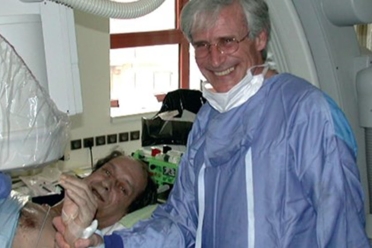In remembrance of Alain Cribier
31 Aug 2024
Today’s Memorial Lecture, remembering the inspirational innovator, Professor Alain Cribier, will be given by one of his closest colleagues and collaborators, Professor Hélène Eltchaninoff.
Born in Paris in 1945, Alain studied medicine there before becoming a resident at the Department of Cardiology at the Charles Nicolle University Hospital, Rouen, working in one of the first cardiac catheterisation laboratories in France. Following a fellowship at Cedars-Sinai Medical Center, Los Angeles, he returned to Rouen, full of ideas about how to address the important clinical unmet needs of the day, including how to provide an alternative therapy for patients with aortic stenosis who were deemed ineligible for surgery.
Alain’s first major development was the use of a balloon to enlarge the narrowed calcified aortic valve. After he performed the first balloon aortic valvuloplasty in 1985, the procedure became widely accepted, but it became apparent that its effects were short lived due to early aortic valve restenosis. Rather than give up his search, Alain came up with a new solution – a ‘stented valve’ delivered by balloon inflation – but there was widespread condemnation of his ‘crazy idea’. Despite this, he persevered and conducted landmark autopsy studies to explore feasibility in the early 1990s. While waiting for funding to develop the prototype for his aortic valve innovation, Alain’s creativity continued and he developed a solution for mitral valve stenosis, performing the first percutaneous metallic mitral commissurotomy in 1996.
Alain finally found support for his stented aortic valve concept from cardiologist, Martin Leon and engineers, Stan Rabinovich and Stan Rowe, who together launched Percutaneous Valve Technologies (PVT) in 1999. They developed the first prototypes with Israel-based Aran R&D. From 2000, Alain and Hélène Eltchaninoff conducted successful studies, implanting more than 100 PVT aortic valve devices in sheep models over a 2-year period in both acute and chronic studies.
More than 20 years after his initial thoughts about an effective non-surgical solution, Alain performed, with Hélène Eltchaninoff and Christophe Tron, the first-ever transcatheter aortic valve implantation (TAVI) in April 2002, in a man with severe aortic stenosis in cardiogenic shock who had been declined by three cardiac surgery teams due to multiple comorbidities.

Alain Cribier with the first TAVI patient, Rouen, 16 April 2002
“Within minutes, his blood pressure was returning to normal and his grey complexion turned a healthy pink colour. The elation that we felt was incredible and we eagerly relayed our success to the rest of the PVT team, having a sleepless night in the US. We had faced an uphill battle to get to this stage, but we knew there was a huge clinical unmet need; we trusted in our idea and our perseverance paid off. You can either give up or you can find solutions and that is what we did.”
Since the success of this first TAVI, more than 3 million patients have been treated with the procedure that Alain pioneered. Originally limited to “compassionate” use in high surgical risk patients, indications have been expanded to include patients at intermediate risk and finally, in 2021, to include low-risk patients as well. Over the years, Alain inspired countless interventional cardiologists with his training programmes. He established the Rouen Medical Training Center and remained an active educator until his untimely death in February 2024.
Hélène Eltchaninoff: “Alain was a true innovator, an excellent interventional cardiologist but, above all, he was a doctor. His patients loved him – they felt his closeness, appreciated his simple explanations, the time he gave each and every one of them and, most significantly, his optimism for the future, which he passed on to them.
Alain was tireless, simple and so accessible, a perfectionist who always strived for excellence, for himself and for his colleagues. He inspired so many people with the story of his incredible adventure: from balloon dilatation to TAVI via the mitral commissurotomy. The impact of his innovations and subsequent work is not limited to cardiology but has rippled through many areas of the practice of medicine today.
He was a generous, caring man, whose eternal smile was a joy to behold. It is a great sadness to no longer be at his side.”


